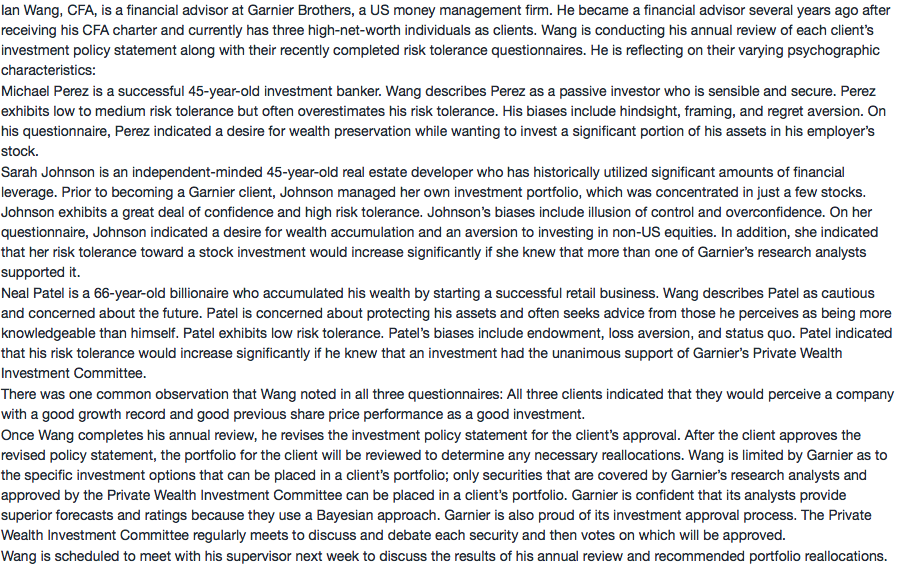NO.PZ201511190100000403
问题如下:
Ian Wang, CFA, is a financial advisor at Garnier Brothers, a US money management firm. He became a financial advisor several years ago after receiving his CFA charter and currently has three high-net-worth individuals as clients. Wang is conducting his annual review of each client’s investment policy statement along with their recently completed risk tolerance questionnaires. He is reflecting on their varying psychographic characteristics:
- Michael Perez is a successful 45-year-old investment banker. Wang describes Perez as a passive investor who is sensible and secure. Perez exhibits low to medium risk tolerance but often overestimates his risk tolerance. His biases include hindsight, framing, and regret aversion. On his questionnaire, Perez indicated a desire for wealth preservation while wanting to invest a significant portion of his assets in his employer’s stock.
- Sarah Johnson is an independent-minded 45-year-old real estate developer who has historically utilized significant amounts of financial leverage. Prior to becoming a Garnier client, Johnson managed her own investment portfolio, which was concentrated in just a few stocks. Johnson exhibits a great deal of confidence and high risk tolerance. Johnson’s biases include illusion of control and overconfidence. On her questionnaire, Johnson indicated a desire for wealth accumulation and an aversion to investing in non-US equities. In addition, she indicated that her risk tolerance toward a stock investment would increase significantly if she knew that more than one of Garnier’s research analysts supported it.
- Neal Patel is a 66-year-old billionaire who accumulated his wealth by starting a successful retail business. Wang describes Patel as cautious and concerned about the future. Patel is concerned about protecting his assets and often seeks advice from those he perceives as being more knowledgeable than himself. Patel exhibits low risk tolerance. Patel’s biases include endowment, loss aversion, and status quo. Patel indicated that his risk tolerance would increase significantly if he knew that an investment had the unanimous support of Garnier’s Private Wealth Investment Committee.
There was one common observation that Wang noted in all three questionnaires: All three clients indicated that they would perceive a company with a good growth record and good previous share price performance as a good investment.
Once Wang completes his annual review, he revises the investment policy statement for the client’s approval. After the client approves the revised policy statement, the portfolio for the client will be reviewed to determine any necessary reallocations. Wang is limited by Garnier as to the specific investment options that can be placed in a client’s portfolio; only securities that are covered by Garnier’s research analysts and approved by the Private Wealth Investment Committee can be placed in a client’s portfolio. Garnier is confident that its analysts provide superior forecasts and ratings because they use a Bayesian approach. Garnier is also proud of its investment approval process. The Private Wealth Investment Committee regularly meets to discuss and debate each security and then votes on which will be approved.
Wang is scheduled to meet with his supervisor next week to discuss the results of his annual review and recommended portfolio reallocations.
Which of the following behavioral biases would be most relevant in constructing a portfolio for Johnson?
选项:
A.
Home bias.
B.
Overconfidence.
C.
Inertia and default.
解释:
A is correct.
Home bias is evident in Johnson’s questionnaire. Johnson has expressed an aversion to investing in non-US equities. Familiarity with their country may lead investors to own high concentrations of domestic assets and ignore the benefits of international diversification.
J这个人已经说他desire non-us equity了,所以更应该说明他没有home bias啊




